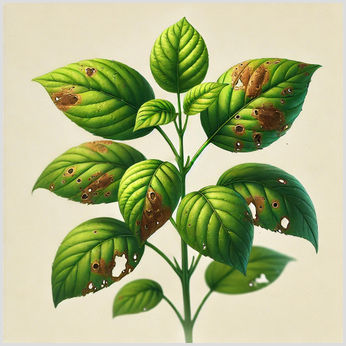Plant diseases range from viral and bacterial infections to fungal infestations. The study of plant illnesses has important implications for agriculture and ecosystems. We explore the most common plant diseases, how to identify them and prevention strategies to keep plants healthy. This article suits all exam boards covering the GCSE Biology syllabus, including AQA and Edexcel. Quiz questions are included to test your knowledge.
If you need more support, TeachTutti has verified GCSE Science tutors who can guide you through this and related topics, whether you are studying single science or combined science.
What are plant diseases?
Plant diseases are caused by pathogens like fungi, bacteria and viruses. They affect the normal functions of the plant, affecting their growth, appearance and yield. Studying the pathogen type helps find a suitable treatment.
- Fungi: A very common disease across all plant species that leaves dark, patchy spots on leaves, causing them to turn yellow and fall to the ground. The plant may be weakened and unable to effectively photosynthesise. An example is Rose black spot.
- Viruses: Viral infections leave mosaic patterns on the leaves, which shows the plant is diseased and causes stunted growth. An example is the Tobacco mosaic virus (TMV).
- Bacteria: Less common and results in tumour-like growths on the plant stems and roots. An example is Crown gall.
1
What pathogen causes Rose black spot?
Common plant diseases
The following are the most common plant diseases. Understanding the specific pathogen causing illnesses helps ensure future plant diseases can be prevented:
- Rose black spot: This fungal disease causes black/purple spots, which make the leaves turn yellow and fall off. It is often seen in roses and reduces photosynthesis. It spreads through water splashes and can be prevented by removing infected leaves and using fungicides.
- Tobacco mosaic virus (TMV): TMV affects tobacco plants among others, including tomatoes. Affected plants will be showing symptoms of discolouration, turning leaves into a pattern of light and dark green. It stunts the plant's growth and ability to photosynthesize. The virus spreads through contact with infected plants or contaminated tools.
- Crown gall disease: It creates tumour-like growths at the surface of the stem and roots. It's caused by the bacterium Agrobacterium tumefaciens and weakens the plant by disrupting its nutrients and water transport. The bacterium normally enters through wounds in the plant and can spread through soil.
2
What pathogen type causes Crown Gall Disease?
Detection and identification: symptoms of plant diseases
An effective defense against plant diseases is early detection and identification. These are the common methods in science and gardening manuals to diagnose these illnesses:
- Visual inspection: The most effective and straightforward method for spotting plant diseases is by looking for visual signs. This includes gardeners looking for spots, wilting, discolouration and growth deformities e.g. the Tobacco mosaic virus leaves a mottled appearance on the plant.
- Diagnostic testing: Testing kits or lab analyses are used in professional and agricultural settings to look for specific pathogens. A common test is taking leaf or soil samples and looking for bacterial or viral DNA and spores. Sometimes, a small cutting of an infected plant will be used to identify and treat the disease. Cuttings are particularly useful when the disease is tricky to identify as they can be analysed by using testing kits containing monoclonal antibodies.
- Technology: Technology plays an increasing role in monitoring crops for signs of stress or disease, Drones can spot problems in plants from above, useful across large fields. The incorporation of technology can show issues before they become visible to the naked eye, such as using multispectral cameras.
Impact of plant diseases
Plant diseases can have serious consequences for society. We have listed common economic and environmental impacts and historical examples:
- Environmental impact: The spread of disease can devastate local plant populations and entire ecosystems. For example, animals and insects sometimes rely on a specific plant for food and habitat. Practicing good identification and early detection is needed to reduce the spread. Plant loss can also lower oxygen levels and carbon sequestration, affecting local air quality and climate regulation.
- Economic consequences: The loss of crops can cause significant financial losses for farmers and agricultural industries. Crops affected by diseases like wheat rust or ash dieback may lead to reduced yields and lower-quality produce. This can increase food prices and impact food security.
- Historical examples: The Irish Potato Famine happened in the 1840s. It was caused by a water mould called Phytophthora infestans, a type of water mould. It caused catastrophic crop failure, mass starvation and significant socio-economic consequences. Approximately 1 million Irish people died and at least another million had to leave their homes as refugees. Read History's article to learn more about the Irish Potato Famine.
3
What is a major agricultural consequence of plant disease?
Defense and treatment of Plant Diseases
Maintaining healthy crops and ecosystems requires preventing and managing plant diseases before they take hold. Combining multiple strategies is a good idea to safeguard plant health.
The key ideas discussed here are in addition to the natural defense mechanisms of a plant. For instance, bark is a thick layer of dead cells that forms a physical barrier and stops infections from being able to pierce the surface.
- Cultural practices: Basic methods to prevent the spread of disease include crop rotation. This breaks the life cycle of pathogens by planting different crops and keeping enough space between plants for air circulation. Another practice is to remove and carefully dispose of infected plant material.
- Chemical treatments: Fungicides and bactericides are among the chemical treatments to control plant diseases e.g. fungicides are applied to control Rose black spot. Avoid relying on this method as overuse can lead to pathogen resistance and environmental issues.
- Biological control: Natural predators are introduced to control disease-causing agents. For example, a greenfly called Aphid can transfer infections to plants. It is controlled by ladybirds, which eat the pest.
- Genetic modification and breeding: Disease-resistant plant varieties have been developed through traditional breeding and genetic modification. It is a long-term solution to make crops less susceptible to dangerous pathogens.
- Quarantine and biosecurity: These measures stop new diseases from being released in a region. For example, you will need a certificate to import a plant abroad to confirm it doesn't contain non-native pathogens.
4
How can you manage plant diseases in an environmentally friendly way?
Interesting Facts and Case Studies
There are plenty of real-world examples and plant disease-related facts. Here are some notable case studies and facts that highlight the impact and nature of plant diseases:
- The Irish Potato Famine: The event also known as late blight affected Ireland in the 1840s when Phytophthora infestans devastated potato crops across the country. It resulted in famine and a significant population decline caused by death from starvation and emigration. It underscores the societal impact that plant diseases can have.
- Dutch Elm disease: Millions of elm trees were killed by this fungal disease in Europe and North America. Beetles carried spores of the fungus Ophiostoma ulmi (later called Ophiostoma novo-ulmi) from tree to tree in the early 20th century. It nearly eradicated native elm species in affected areas, reshaping forests and urban landscapes.
- Advances in disease detection: Recent developments in disease detection have used AI and image recognition to spot the early onset of plant disease. This technology helps farmers and researchers take action to mitigate damage and loss.
- Lesser-known diseases: There are rarer diseases that affect plant life. For example, fire blight is a bacterial disease caused by Erwinia amylovora that affects apple and pear trees. The leaves appear scorched and can spread quickly through orchards when left unchecked.
5
What plant disease devastated elm trees in Europe and North America?
GCSE Biology revision notes
Using the right strategies, the complexities of plant diseases can be mastered confidently by GCSE Science students when tackling related exam questions. These are a few tips for studying plant diseases in your exams:
- Create diagrams and flowcharts: Visual aids are a great way to remember the types of plant diseases, their causes and effects. Draw plant diagrams with symptoms clearly labelled to solidify your understanding, in part by repetition.
- Practice questions: Use exam-style questions in your revision - including past papers - to familiarise yourself with how the topic will appear in your exam.
- Summarise key points: Keep your revision notes concise, clear and structured. For each major plant disease, focus on the pathogen type, symptoms, prevention and treatment strategies.
- Use real-world examples: Try to make the topic relatable using real-life scenarios or historical events, like the Irish Potato Famine. Reference these examples in your answers to highlight your deep understanding of the topic.
Conclusion - Plant pathogens
We have explored how plant health is affected by pathogens and the effects on ecosystems and economies. Early identification is crucial to manage the symptoms and save the plant or crop. To test your understanding, ExamPapersPractice has plant disease worksheets.
If you need further support, you can find high-quality GCSE science tutors to help you with revision notes and past paper questions. Lessons can be in-person or online.

